Management in Community Service: Roles, Impact & Functioning NGOs
VerifiedAdded on 2023/03/30
|6
|1697
|262
Essay
AI Summary
This essay provides an introduction to management within the context of community service, focusing on the roles managers play and their impact on the functioning of non-governmental organizations (NGOs). It uses the Australian Red Cross as an example, detailing management roles such as figurehead, leader, liaison, monitor, disseminator, and representative. The essay further explores decisional roles like entrepreneurship, handling challenges, resource distribution, and negotiation. It concludes that effective management significantly impacts organizational functioning by fostering motivation, good leadership, strong connections, and efficient resource allocation, all contributing to the achievement of the organization's goals in serving the community.
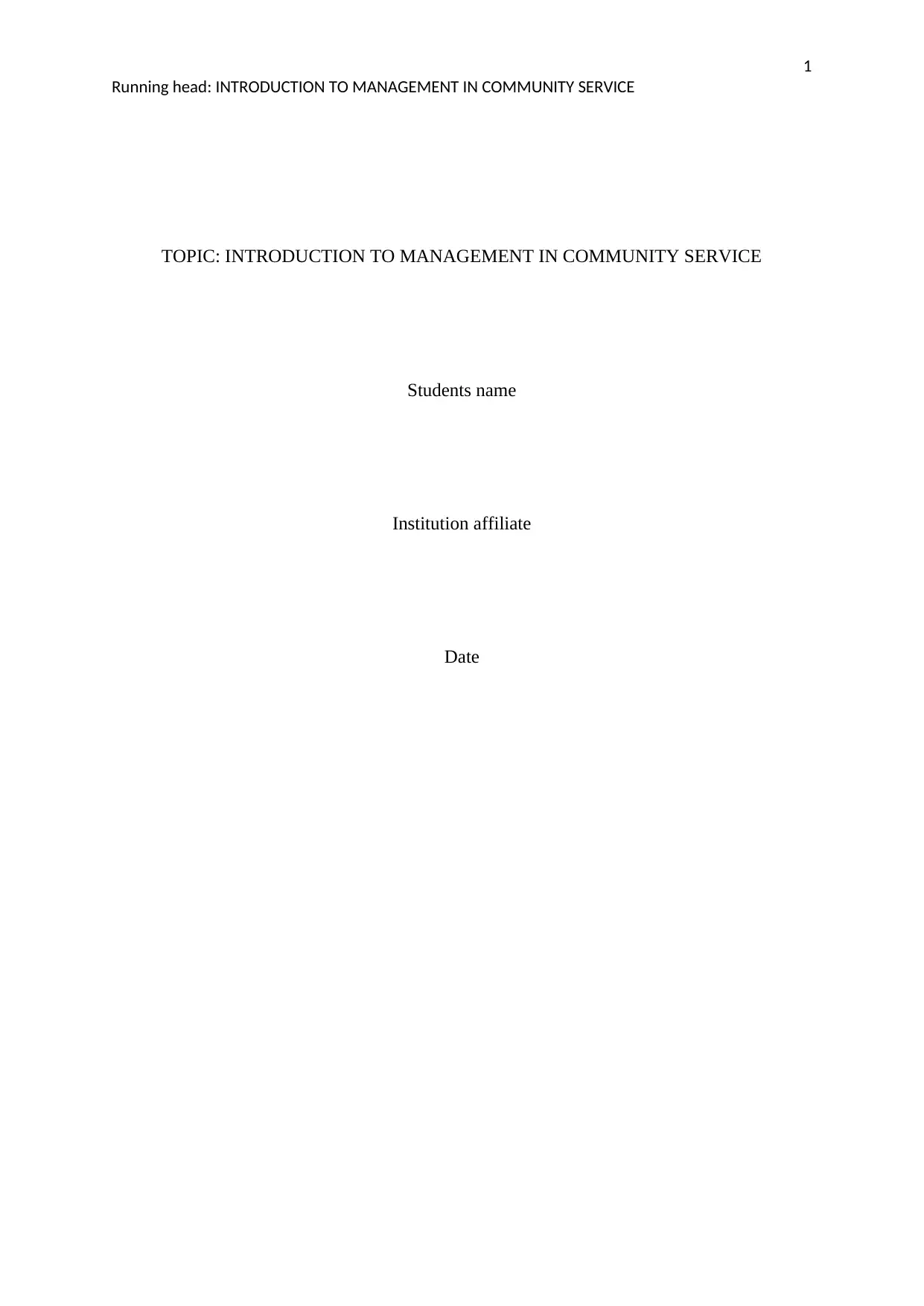
1
Running head: INTRODUCTION TO MANAGEMENT IN COMMUNITY SERVICE
TOPIC: INTRODUCTION TO MANAGEMENT IN COMMUNITY SERVICE
Students name
Institution affiliate
Date
Running head: INTRODUCTION TO MANAGEMENT IN COMMUNITY SERVICE
TOPIC: INTRODUCTION TO MANAGEMENT IN COMMUNITY SERVICE
Students name
Institution affiliate
Date
Paraphrase This Document
Need a fresh take? Get an instant paraphrase of this document with our AI Paraphraser
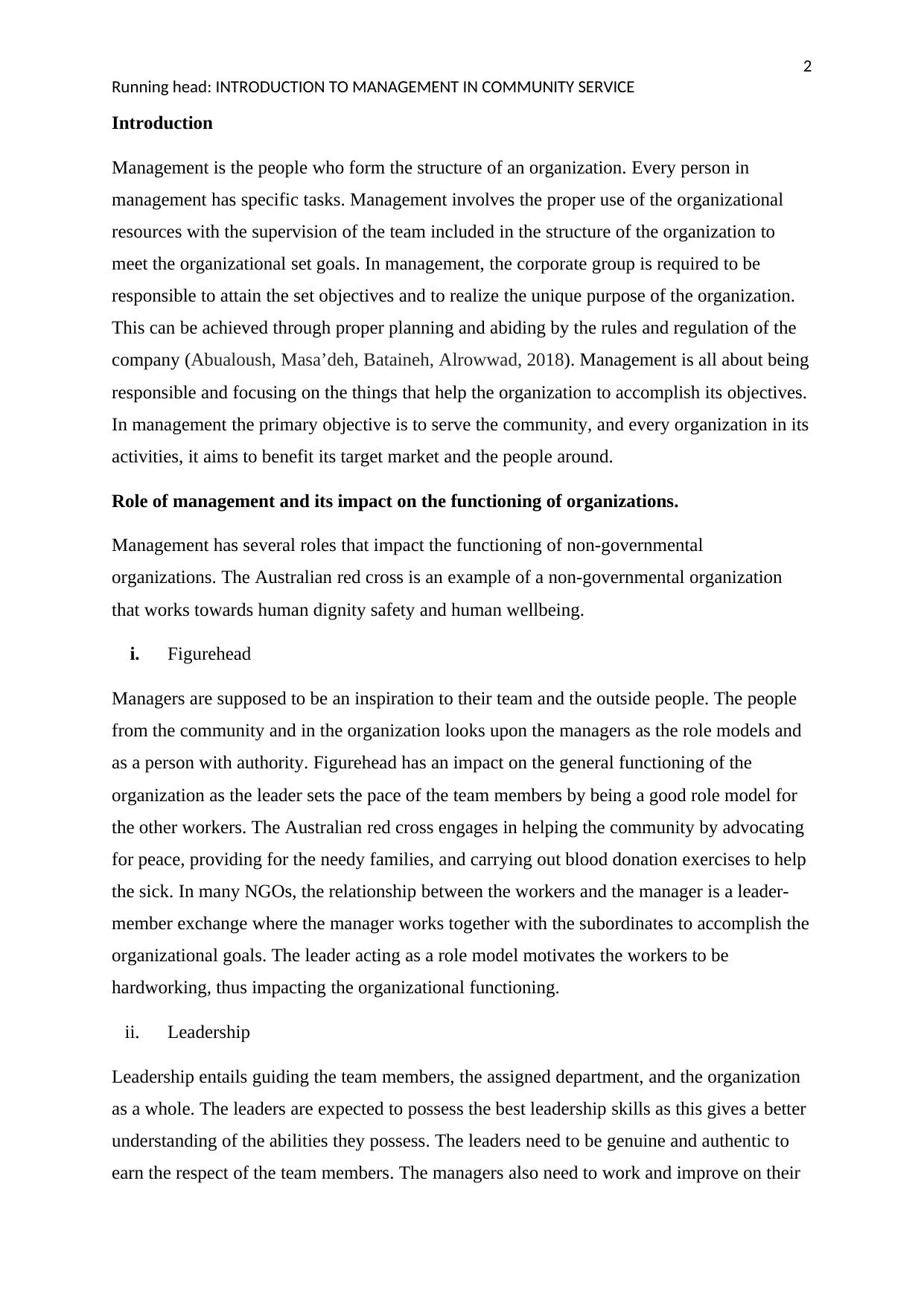
2
Running head: INTRODUCTION TO MANAGEMENT IN COMMUNITY SERVICE
Introduction
Management is the people who form the structure of an organization. Every person in
management has specific tasks. Management involves the proper use of the organizational
resources with the supervision of the team included in the structure of the organization to
meet the organizational set goals. In management, the corporate group is required to be
responsible to attain the set objectives and to realize the unique purpose of the organization.
This can be achieved through proper planning and abiding by the rules and regulation of the
company (Abualoush, Masa’deh, Bataineh, Alrowwad, 2018). Management is all about being
responsible and focusing on the things that help the organization to accomplish its objectives.
In management the primary objective is to serve the community, and every organization in its
activities, it aims to benefit its target market and the people around.
Role of management and its impact on the functioning of organizations.
Management has several roles that impact the functioning of non-governmental
organizations. The Australian red cross is an example of a non-governmental organization
that works towards human dignity safety and human wellbeing.
i. Figurehead
Managers are supposed to be an inspiration to their team and the outside people. The people
from the community and in the organization looks upon the managers as the role models and
as a person with authority. Figurehead has an impact on the general functioning of the
organization as the leader sets the pace of the team members by being a good role model for
the other workers. The Australian red cross engages in helping the community by advocating
for peace, providing for the needy families, and carrying out blood donation exercises to help
the sick. In many NGOs, the relationship between the workers and the manager is a leader-
member exchange where the manager works together with the subordinates to accomplish the
organizational goals. The leader acting as a role model motivates the workers to be
hardworking, thus impacting the organizational functioning.
ii. Leadership
Leadership entails guiding the team members, the assigned department, and the organization
as a whole. The leaders are expected to possess the best leadership skills as this gives a better
understanding of the abilities they possess. The leaders need to be genuine and authentic to
earn the respect of the team members. The managers also need to work and improve on their
Running head: INTRODUCTION TO MANAGEMENT IN COMMUNITY SERVICE
Introduction
Management is the people who form the structure of an organization. Every person in
management has specific tasks. Management involves the proper use of the organizational
resources with the supervision of the team included in the structure of the organization to
meet the organizational set goals. In management, the corporate group is required to be
responsible to attain the set objectives and to realize the unique purpose of the organization.
This can be achieved through proper planning and abiding by the rules and regulation of the
company (Abualoush, Masa’deh, Bataineh, Alrowwad, 2018). Management is all about being
responsible and focusing on the things that help the organization to accomplish its objectives.
In management the primary objective is to serve the community, and every organization in its
activities, it aims to benefit its target market and the people around.
Role of management and its impact on the functioning of organizations.
Management has several roles that impact the functioning of non-governmental
organizations. The Australian red cross is an example of a non-governmental organization
that works towards human dignity safety and human wellbeing.
i. Figurehead
Managers are supposed to be an inspiration to their team and the outside people. The people
from the community and in the organization looks upon the managers as the role models and
as a person with authority. Figurehead has an impact on the general functioning of the
organization as the leader sets the pace of the team members by being a good role model for
the other workers. The Australian red cross engages in helping the community by advocating
for peace, providing for the needy families, and carrying out blood donation exercises to help
the sick. In many NGOs, the relationship between the workers and the manager is a leader-
member exchange where the manager works together with the subordinates to accomplish the
organizational goals. The leader acting as a role model motivates the workers to be
hardworking, thus impacting the organizational functioning.
ii. Leadership
Leadership entails guiding the team members, the assigned department, and the organization
as a whole. The leaders are expected to possess the best leadership skills as this gives a better
understanding of the abilities they possess. The leaders need to be genuine and authentic to
earn the respect of the team members. The managers also need to work and improve on their
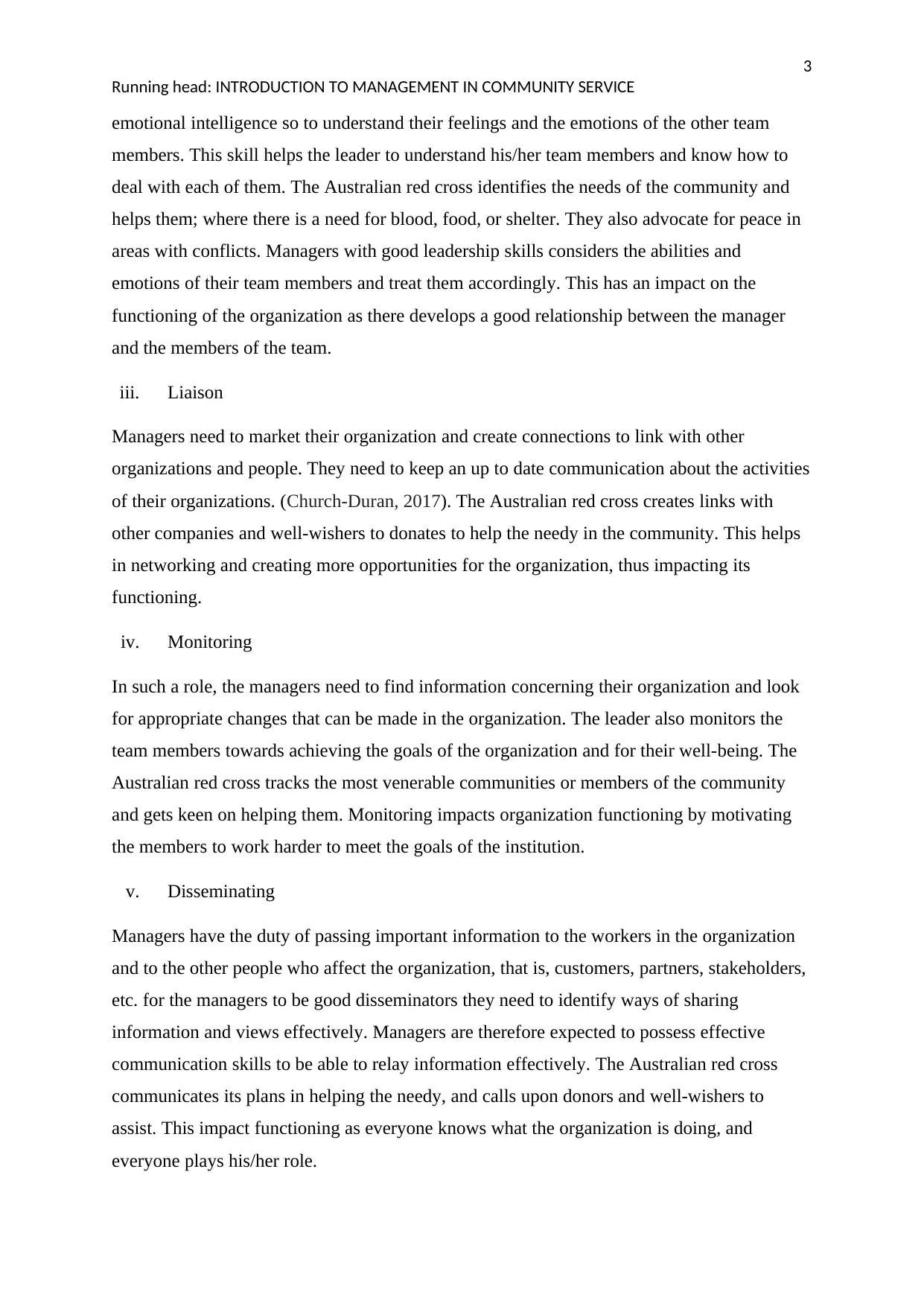
3
Running head: INTRODUCTION TO MANAGEMENT IN COMMUNITY SERVICE
emotional intelligence so to understand their feelings and the emotions of the other team
members. This skill helps the leader to understand his/her team members and know how to
deal with each of them. The Australian red cross identifies the needs of the community and
helps them; where there is a need for blood, food, or shelter. They also advocate for peace in
areas with conflicts. Managers with good leadership skills considers the abilities and
emotions of their team members and treat them accordingly. This has an impact on the
functioning of the organization as there develops a good relationship between the manager
and the members of the team.
iii. Liaison
Managers need to market their organization and create connections to link with other
organizations and people. They need to keep an up to date communication about the activities
of their organizations. (Church-Duran, 2017). The Australian red cross creates links with
other companies and well-wishers to donates to help the needy in the community. This helps
in networking and creating more opportunities for the organization, thus impacting its
functioning.
iv. Monitoring
In such a role, the managers need to find information concerning their organization and look
for appropriate changes that can be made in the organization. The leader also monitors the
team members towards achieving the goals of the organization and for their well-being. The
Australian red cross tracks the most venerable communities or members of the community
and gets keen on helping them. Monitoring impacts organization functioning by motivating
the members to work harder to meet the goals of the institution.
v. Disseminating
Managers have the duty of passing important information to the workers in the organization
and to the other people who affect the organization, that is, customers, partners, stakeholders,
etc. for the managers to be good disseminators they need to identify ways of sharing
information and views effectively. Managers are therefore expected to possess effective
communication skills to be able to relay information effectively. The Australian red cross
communicates its plans in helping the needy, and calls upon donors and well-wishers to
assist. This impact functioning as everyone knows what the organization is doing, and
everyone plays his/her role.
Running head: INTRODUCTION TO MANAGEMENT IN COMMUNITY SERVICE
emotional intelligence so to understand their feelings and the emotions of the other team
members. This skill helps the leader to understand his/her team members and know how to
deal with each of them. The Australian red cross identifies the needs of the community and
helps them; where there is a need for blood, food, or shelter. They also advocate for peace in
areas with conflicts. Managers with good leadership skills considers the abilities and
emotions of their team members and treat them accordingly. This has an impact on the
functioning of the organization as there develops a good relationship between the manager
and the members of the team.
iii. Liaison
Managers need to market their organization and create connections to link with other
organizations and people. They need to keep an up to date communication about the activities
of their organizations. (Church-Duran, 2017). The Australian red cross creates links with
other companies and well-wishers to donates to help the needy in the community. This helps
in networking and creating more opportunities for the organization, thus impacting its
functioning.
iv. Monitoring
In such a role, the managers need to find information concerning their organization and look
for appropriate changes that can be made in the organization. The leader also monitors the
team members towards achieving the goals of the organization and for their well-being. The
Australian red cross tracks the most venerable communities or members of the community
and gets keen on helping them. Monitoring impacts organization functioning by motivating
the members to work harder to meet the goals of the institution.
v. Disseminating
Managers have the duty of passing important information to the workers in the organization
and to the other people who affect the organization, that is, customers, partners, stakeholders,
etc. for the managers to be good disseminators they need to identify ways of sharing
information and views effectively. Managers are therefore expected to possess effective
communication skills to be able to relay information effectively. The Australian red cross
communicates its plans in helping the needy, and calls upon donors and well-wishers to
assist. This impact functioning as everyone knows what the organization is doing, and
everyone plays his/her role.
⊘ This is a preview!⊘
Do you want full access?
Subscribe today to unlock all pages.

Trusted by 1+ million students worldwide
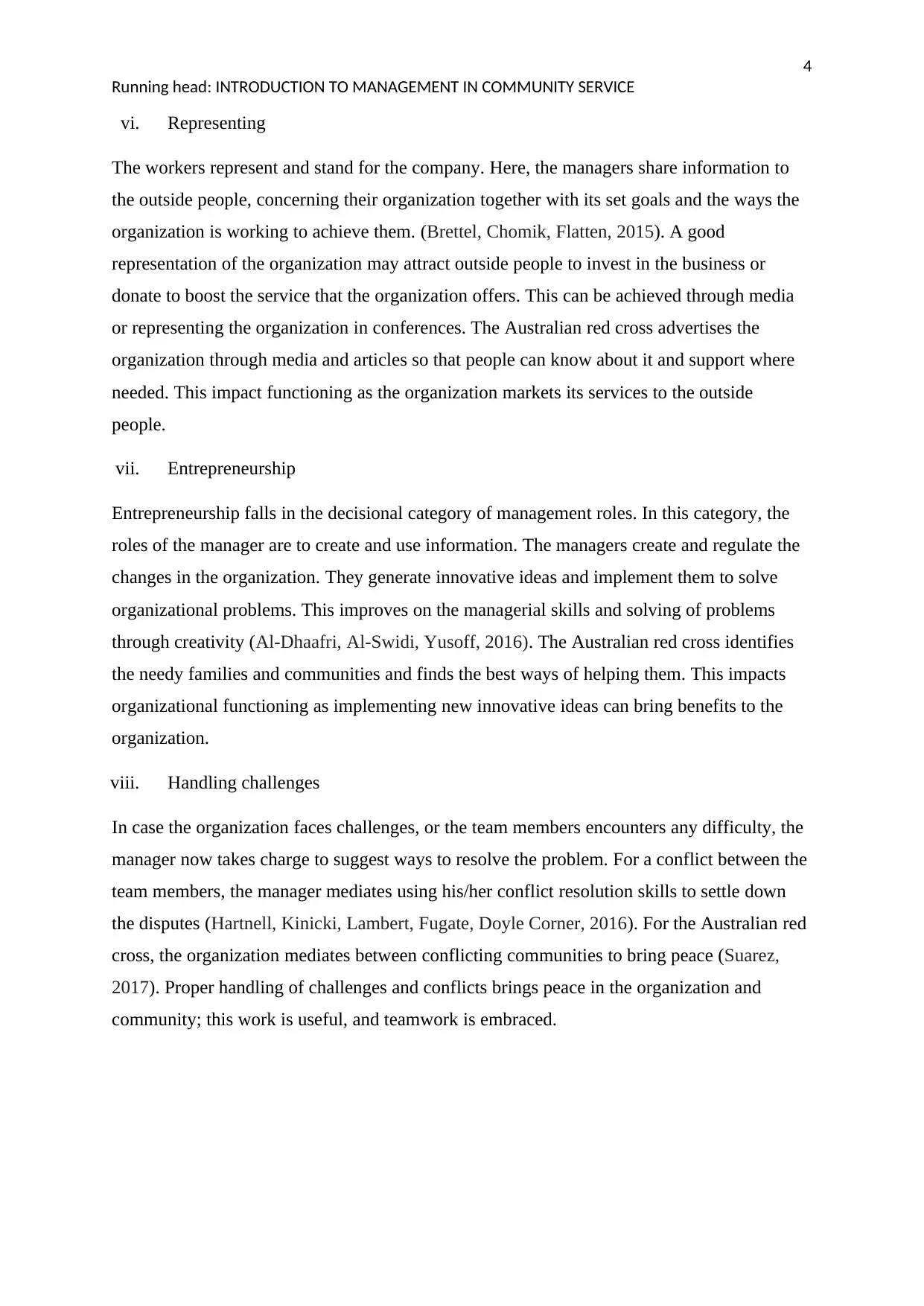
4
Running head: INTRODUCTION TO MANAGEMENT IN COMMUNITY SERVICE
vi. Representing
The workers represent and stand for the company. Here, the managers share information to
the outside people, concerning their organization together with its set goals and the ways the
organization is working to achieve them. (Brettel, Chomik, Flatten, 2015). A good
representation of the organization may attract outside people to invest in the business or
donate to boost the service that the organization offers. This can be achieved through media
or representing the organization in conferences. The Australian red cross advertises the
organization through media and articles so that people can know about it and support where
needed. This impact functioning as the organization markets its services to the outside
people.
vii. Entrepreneurship
Entrepreneurship falls in the decisional category of management roles. In this category, the
roles of the manager are to create and use information. The managers create and regulate the
changes in the organization. They generate innovative ideas and implement them to solve
organizational problems. This improves on the managerial skills and solving of problems
through creativity (Al-Dhaafri, Al-Swidi, Yusoff, 2016). The Australian red cross identifies
the needy families and communities and finds the best ways of helping them. This impacts
organizational functioning as implementing new innovative ideas can bring benefits to the
organization.
viii. Handling challenges
In case the organization faces challenges, or the team members encounters any difficulty, the
manager now takes charge to suggest ways to resolve the problem. For a conflict between the
team members, the manager mediates using his/her conflict resolution skills to settle down
the disputes (Hartnell, Kinicki, Lambert, Fugate, Doyle Corner, 2016). For the Australian red
cross, the organization mediates between conflicting communities to bring peace (Suarez,
2017). Proper handling of challenges and conflicts brings peace in the organization and
community; this work is useful, and teamwork is embraced.
Running head: INTRODUCTION TO MANAGEMENT IN COMMUNITY SERVICE
vi. Representing
The workers represent and stand for the company. Here, the managers share information to
the outside people, concerning their organization together with its set goals and the ways the
organization is working to achieve them. (Brettel, Chomik, Flatten, 2015). A good
representation of the organization may attract outside people to invest in the business or
donate to boost the service that the organization offers. This can be achieved through media
or representing the organization in conferences. The Australian red cross advertises the
organization through media and articles so that people can know about it and support where
needed. This impact functioning as the organization markets its services to the outside
people.
vii. Entrepreneurship
Entrepreneurship falls in the decisional category of management roles. In this category, the
roles of the manager are to create and use information. The managers create and regulate the
changes in the organization. They generate innovative ideas and implement them to solve
organizational problems. This improves on the managerial skills and solving of problems
through creativity (Al-Dhaafri, Al-Swidi, Yusoff, 2016). The Australian red cross identifies
the needy families and communities and finds the best ways of helping them. This impacts
organizational functioning as implementing new innovative ideas can bring benefits to the
organization.
viii. Handling challenges
In case the organization faces challenges, or the team members encounters any difficulty, the
manager now takes charge to suggest ways to resolve the problem. For a conflict between the
team members, the manager mediates using his/her conflict resolution skills to settle down
the disputes (Hartnell, Kinicki, Lambert, Fugate, Doyle Corner, 2016). For the Australian red
cross, the organization mediates between conflicting communities to bring peace (Suarez,
2017). Proper handling of challenges and conflicts brings peace in the organization and
community; this work is useful, and teamwork is embraced.
Paraphrase This Document
Need a fresh take? Get an instant paraphrase of this document with our AI Paraphraser
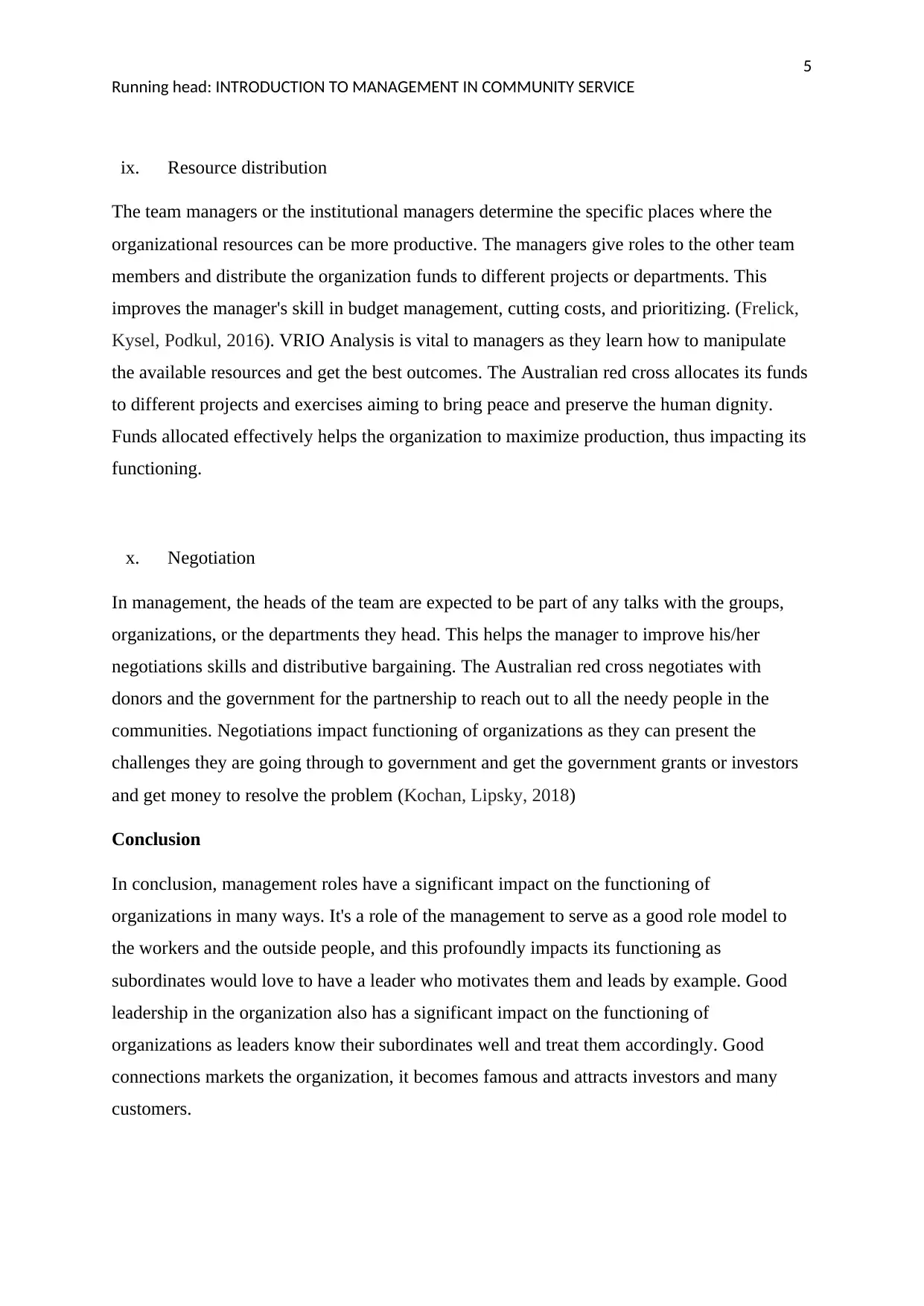
5
Running head: INTRODUCTION TO MANAGEMENT IN COMMUNITY SERVICE
ix. Resource distribution
The team managers or the institutional managers determine the specific places where the
organizational resources can be more productive. The managers give roles to the other team
members and distribute the organization funds to different projects or departments. This
improves the manager's skill in budget management, cutting costs, and prioritizing. (Frelick,
Kysel, Podkul, 2016). VRIO Analysis is vital to managers as they learn how to manipulate
the available resources and get the best outcomes. The Australian red cross allocates its funds
to different projects and exercises aiming to bring peace and preserve the human dignity.
Funds allocated effectively helps the organization to maximize production, thus impacting its
functioning.
x. Negotiation
In management, the heads of the team are expected to be part of any talks with the groups,
organizations, or the departments they head. This helps the manager to improve his/her
negotiations skills and distributive bargaining. The Australian red cross negotiates with
donors and the government for the partnership to reach out to all the needy people in the
communities. Negotiations impact functioning of organizations as they can present the
challenges they are going through to government and get the government grants or investors
and get money to resolve the problem (Kochan, Lipsky, 2018)
Conclusion
In conclusion, management roles have a significant impact on the functioning of
organizations in many ways. It's a role of the management to serve as a good role model to
the workers and the outside people, and this profoundly impacts its functioning as
subordinates would love to have a leader who motivates them and leads by example. Good
leadership in the organization also has a significant impact on the functioning of
organizations as leaders know their subordinates well and treat them accordingly. Good
connections markets the organization, it becomes famous and attracts investors and many
customers.
Running head: INTRODUCTION TO MANAGEMENT IN COMMUNITY SERVICE
ix. Resource distribution
The team managers or the institutional managers determine the specific places where the
organizational resources can be more productive. The managers give roles to the other team
members and distribute the organization funds to different projects or departments. This
improves the manager's skill in budget management, cutting costs, and prioritizing. (Frelick,
Kysel, Podkul, 2016). VRIO Analysis is vital to managers as they learn how to manipulate
the available resources and get the best outcomes. The Australian red cross allocates its funds
to different projects and exercises aiming to bring peace and preserve the human dignity.
Funds allocated effectively helps the organization to maximize production, thus impacting its
functioning.
x. Negotiation
In management, the heads of the team are expected to be part of any talks with the groups,
organizations, or the departments they head. This helps the manager to improve his/her
negotiations skills and distributive bargaining. The Australian red cross negotiates with
donors and the government for the partnership to reach out to all the needy people in the
communities. Negotiations impact functioning of organizations as they can present the
challenges they are going through to government and get the government grants or investors
and get money to resolve the problem (Kochan, Lipsky, 2018)
Conclusion
In conclusion, management roles have a significant impact on the functioning of
organizations in many ways. It's a role of the management to serve as a good role model to
the workers and the outside people, and this profoundly impacts its functioning as
subordinates would love to have a leader who motivates them and leads by example. Good
leadership in the organization also has a significant impact on the functioning of
organizations as leaders know their subordinates well and treat them accordingly. Good
connections markets the organization, it becomes famous and attracts investors and many
customers.
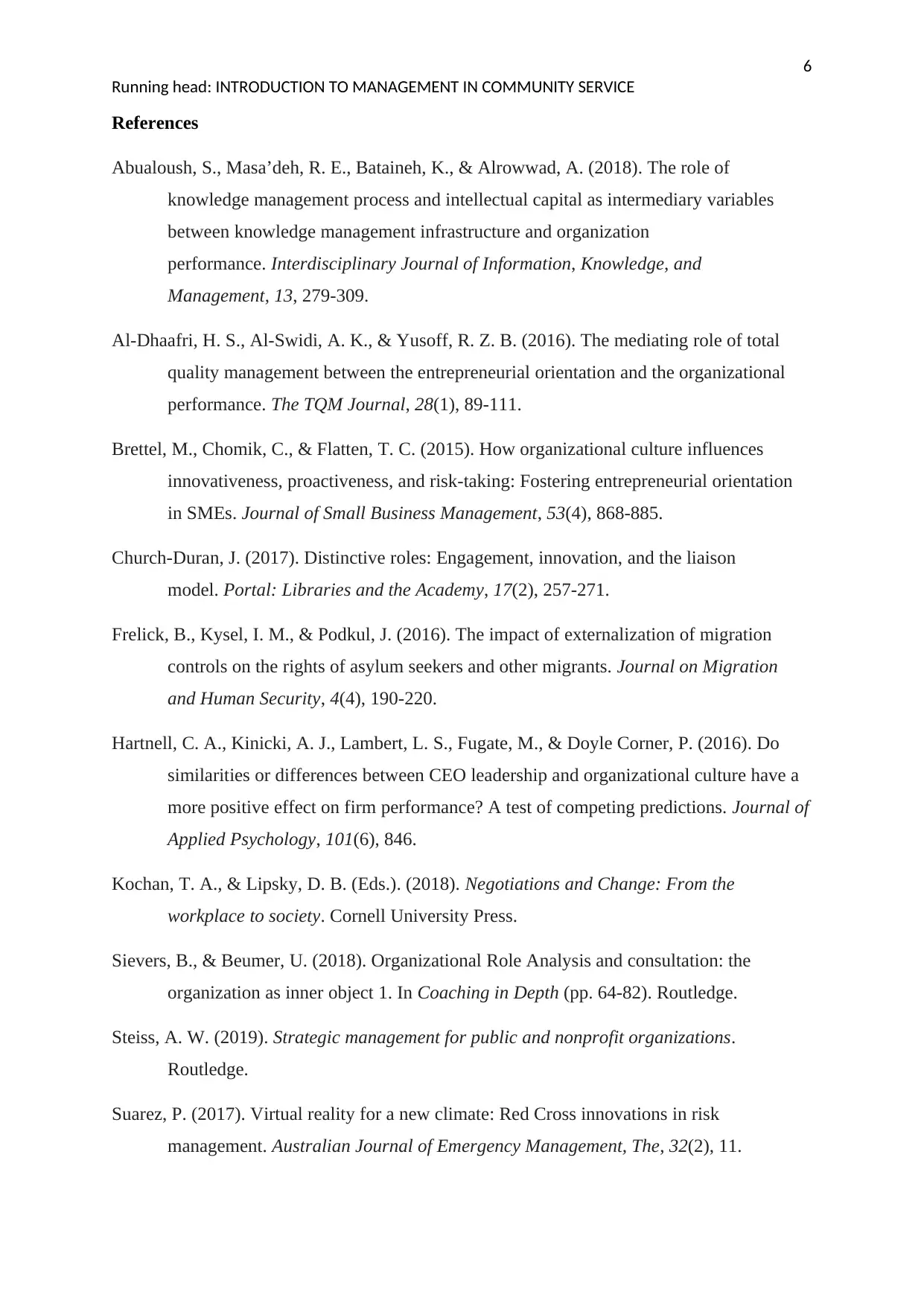
6
Running head: INTRODUCTION TO MANAGEMENT IN COMMUNITY SERVICE
References
Abualoush, S., Masa’deh, R. E., Bataineh, K., & Alrowwad, A. (2018). The role of
knowledge management process and intellectual capital as intermediary variables
between knowledge management infrastructure and organization
performance. Interdisciplinary Journal of Information, Knowledge, and
Management, 13, 279-309.
Al-Dhaafri, H. S., Al-Swidi, A. K., & Yusoff, R. Z. B. (2016). The mediating role of total
quality management between the entrepreneurial orientation and the organizational
performance. The TQM Journal, 28(1), 89-111.
Brettel, M., Chomik, C., & Flatten, T. C. (2015). How organizational culture influences
innovativeness, proactiveness, and risk‐taking: Fostering entrepreneurial orientation
in SMEs. Journal of Small Business Management, 53(4), 868-885.
Church-Duran, J. (2017). Distinctive roles: Engagement, innovation, and the liaison
model. Portal: Libraries and the Academy, 17(2), 257-271.
Frelick, B., Kysel, I. M., & Podkul, J. (2016). The impact of externalization of migration
controls on the rights of asylum seekers and other migrants. Journal on Migration
and Human Security, 4(4), 190-220.
Hartnell, C. A., Kinicki, A. J., Lambert, L. S., Fugate, M., & Doyle Corner, P. (2016). Do
similarities or differences between CEO leadership and organizational culture have a
more positive effect on firm performance? A test of competing predictions. Journal of
Applied Psychology, 101(6), 846.
Kochan, T. A., & Lipsky, D. B. (Eds.). (2018). Negotiations and Change: From the
workplace to society. Cornell University Press.
Sievers, B., & Beumer, U. (2018). Organizational Role Analysis and consultation: the
organization as inner object 1. In Coaching in Depth (pp. 64-82). Routledge.
Steiss, A. W. (2019). Strategic management for public and nonprofit organizations.
Routledge.
Suarez, P. (2017). Virtual reality for a new climate: Red Cross innovations in risk
management. Australian Journal of Emergency Management, The, 32(2), 11.
Running head: INTRODUCTION TO MANAGEMENT IN COMMUNITY SERVICE
References
Abualoush, S., Masa’deh, R. E., Bataineh, K., & Alrowwad, A. (2018). The role of
knowledge management process and intellectual capital as intermediary variables
between knowledge management infrastructure and organization
performance. Interdisciplinary Journal of Information, Knowledge, and
Management, 13, 279-309.
Al-Dhaafri, H. S., Al-Swidi, A. K., & Yusoff, R. Z. B. (2016). The mediating role of total
quality management between the entrepreneurial orientation and the organizational
performance. The TQM Journal, 28(1), 89-111.
Brettel, M., Chomik, C., & Flatten, T. C. (2015). How organizational culture influences
innovativeness, proactiveness, and risk‐taking: Fostering entrepreneurial orientation
in SMEs. Journal of Small Business Management, 53(4), 868-885.
Church-Duran, J. (2017). Distinctive roles: Engagement, innovation, and the liaison
model. Portal: Libraries and the Academy, 17(2), 257-271.
Frelick, B., Kysel, I. M., & Podkul, J. (2016). The impact of externalization of migration
controls on the rights of asylum seekers and other migrants. Journal on Migration
and Human Security, 4(4), 190-220.
Hartnell, C. A., Kinicki, A. J., Lambert, L. S., Fugate, M., & Doyle Corner, P. (2016). Do
similarities or differences between CEO leadership and organizational culture have a
more positive effect on firm performance? A test of competing predictions. Journal of
Applied Psychology, 101(6), 846.
Kochan, T. A., & Lipsky, D. B. (Eds.). (2018). Negotiations and Change: From the
workplace to society. Cornell University Press.
Sievers, B., & Beumer, U. (2018). Organizational Role Analysis and consultation: the
organization as inner object 1. In Coaching in Depth (pp. 64-82). Routledge.
Steiss, A. W. (2019). Strategic management for public and nonprofit organizations.
Routledge.
Suarez, P. (2017). Virtual reality for a new climate: Red Cross innovations in risk
management. Australian Journal of Emergency Management, The, 32(2), 11.
⊘ This is a preview!⊘
Do you want full access?
Subscribe today to unlock all pages.

Trusted by 1+ million students worldwide
1 out of 6
Related Documents
Your All-in-One AI-Powered Toolkit for Academic Success.
+13062052269
info@desklib.com
Available 24*7 on WhatsApp / Email
![[object Object]](/_next/static/media/star-bottom.7253800d.svg)
Unlock your academic potential
Copyright © 2020–2025 A2Z Services. All Rights Reserved. Developed and managed by ZUCOL.





